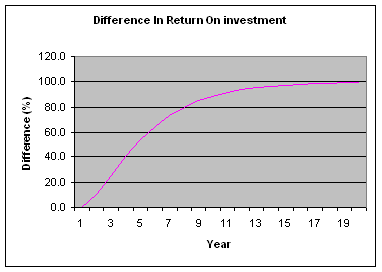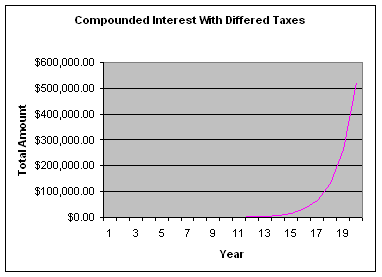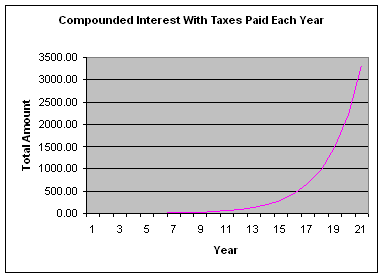How Taxes can Dramatically Affect Your Real Estate Gains
Many people believe that flipping real estate is a good investment strategy, that it can give you a give boost to your pocket book, that holding a property for too long is not a good thing since you should cash your gains out often enough and re-invest it again and again in other properties to flip. This strategy does work for some individuals who are good at find hidden gems and can renovate them at a profit. However, for many this is a very sub-optimal strategy, unless you are doing a 1031 exchange.
What most people don’t realize is that flipping can be very costly. Every time you buy or sell a property, you need to pay the income tax on the capital gains (assuming the highest tax bracket and no 1031 exchange since you need to use the cash to live off of) of 50% on your capital gains, not to mention all the associated professional fees. This means that the next time you buy another property to flip, you lose 50% of your compounding gains. Over time this can drastically reduce your returns to only a very small fraction of what you truly could have gotten with nothing other than just holding your properties over a longer time.
Investing is about making money, not losing money, and one of the best and easiest ways to make money is compounding your gains over and over and over and over… Making $1 into $2, then making that $2 into $4, and so on. I find that a decent amount of investors flip real estate properties as soon as they have a reasonable gain and use that as their earned income. This is all fine and great, but imagine what you could do with those gains if you re-invested them? Since these investors don’t re-invest they lose 50% (assuming the highest tax bracket) of the gains to taxes. Assuming we use our example of $1 to $2, you would then have only made $0.50 to re-invest, not $1. You have just handicapped yourself a 50% compounded gain.
This might not seem like much, but let’s follow this simple example to the next stage, let’s now take that gain and double it again, so our $2 goes to $4. In our example, we take our $1.50 and double it to $3. Now we need to take 50% off of our $1.50 gain to taxes, which gives us a total balance of $2.25. We’re already 10% behind (our $4 is actually $2.50 after taxes as we need to pay 50% taxes on the $3 gain from our initial $1) as shown in the table below.
| Year | Income After taxes paid each year | Income After taxes paid only on the closing date | Difference (%) |
|---|---|---|---|
| 1 | $1.50 | $1.50 | 0 |
| 2 | $2.25 | $2.50 | 10.0 |
| 3 | $3.38 | $4.50 | 24.9 |
| 4 | $5.07 | $8.50 | 40.4 |
| 5 | $7.61 | $16.50 | 53.9 |
| 6 | $11.41 | $32.50 | 64.9 |
| 7 | $17.11 | $64.50 | 73.5 |
| 8 | $25.67 | $128.50 | 80.0 |
| 9 | $38.50 | $256.50 | 85.0 |
| 10 | $57.75 | $512.50 | 88.7 |
| 11 | $86.63 | $1,024.50 | 91.5 |
| 12 | $129.94 | $2,048.50 | 93.7 |
| 13 | $194.91 | $4,096.50 | 95.2 |
| 14 | $292.36 | $8,192.50 | 96.4 |
| 15 | $438.54 | $16,384.50 | 97.3 |
| 16 | $657.81 | $32,768.50 | 98.0 |
| 17 | $986.72 | $65,536.50 | 98.5 |
| 18 | $1480.08 | $131,072.50 | 98.9 |
| 19 | $2220.12 | $262,144.50 | 99.2 |
| 20 | $3330.18 | $524,288.50 | 99.4 |
Let’s take a closer look. Our $4 becomes $8 (remember we only pay taxes at the end in this scenario). In our example, our $2.25 becomes $4.50. After we take out the taxes, we get a total of $3.38. We’re now about 25% behind the person who hasn’t sold their properties until the very end of our sample 20 year time period. By now you can already see how quickly the spread is increasing (as show in the graph below).

If you continue this over 20 years (yes I understand that it becomes increasingly difficult for an individual to double each year for 20 years, however let’s assume for simplicities sake that it does really happen) you will get two very different final numbers! The first person who doubled each year and pays a large tax at the end of the 20 years will have after tax a whopping $524,288.50.

Compared that to our scenario where the only difference is that we flipped our properties each year and paid the capital appreciation tax after each year, we get a total of $3330.18 after taxes.

That’s an amazing difference of $524,288.50 or 99.4%! WOW! This really helps to explain why most investors take advantage of the 1031exchange in the US, or that they refinance their properties to buy new properties (no capital appreciation in this case since you haven’t sold the property, all you’ve actually done is shuffle your debt on the property).
In this perspective, commissions on real estate sales for example don’t seem as significant. Are we indeed spending too much time saving pennies? Compare that potential saving and benefit of holding a property for a long period of time. There is no better way to increase your real rate of return than to purchase properties with consistent growth over long periods of time!



· February 19th, 2007 · 3:52 pm · Permalink
Amateur real-estate investors make a lot of mistakes because they misinterpret tax issues on their investment.
In an earlier column, I addressed two tax codes — Internal Revenue Code 121 and Internal Revenue Code 1031 — that are at the heart of the problem.
Under IRS Code 121, homeowners can keep a gain of up to $250,000 ($500,000 per married couple filing jointly) tax free when selling their principal residence. To qualify for the tax exemption, you must have owned and occupied your residence for two of the five years before the sale.
IRS Code 1031 is a way to defer paying the capital gains tax on the sale of an investment property. Generally, the law allows the exchange of an investment property for another investment property of the same or greater value.
· April 30th, 2008 · 10:28 pm · Permalink
[…] and acquiring it, you’ll make sure it’s a valuable asset for a longer time frame. Buying and selling stocks quickly will dramatically reduce you’re returns, more than you can imagine. It’s worth picking solid stocks, or should I say coffee shops now […]